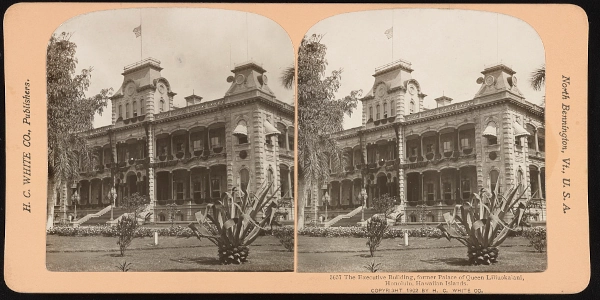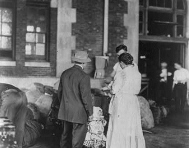Sponsor this page. Your banner or text ad can fill the space above.
Click here to Sponsor the page and how to reserve your ad.
-
Timeline
Detail - 1893
January 14-17, 1893 - The United States Marines, under the direction of U.S. government minister John L. Stevens, but no authority from the U.S. Congress, intervene in the affairs of the independent Kingdom of Hawaii, which culminated in the overthrow of the government of Hawaiian Queen Liliuokalani.

However, although President Grover Cleveland may have had disagreements with her rule, he was not quite where the Committee of Safety were. So when that Committee acted, on January 16, 1893, to defy a martial law order by the Queen backed Hawaiian Marshal Charles B. Wilson, there seems confusion between Washington and Honolulu amongst U.S. officials. However, Wilson's efforts to arrest the Committee of Safety was thwarted by other government officials who feared violence. Violence came one day later anyway; a policeman was shot and the Committee of Safety used the chaos to stage a coup. Using their own militia plus one hundred and sixty-two members of the U.S. Navy and Marines, sent to protect the Committee of white sugar planters and businessmen by U.S. Minister to Hawaii, John L. Stevens (suspected of having knowledge of the coup), the Hawaiian Queen Liliuokalani surrendered on January 17, 1893, without, some think, knowledge of Congress or the President; President Cleveland would later say that it was wrong, unlawful, and illegal.
"I Lili’uokalani, by the Grace of God and under the Constitution of the Hawaiian Kingdom, Queen, do hereby solemnly protest against any and all acts done against myself and the Constitutional Government of the Hawaiian Kingdom by certain persons claiming to have established a Provisional Government of and for this Kingdom. That I yield to the superior force of the United States of America whose Minister Plenipotentiary, His Excellency John L. Stevens, has caused United States troops to be landed at Honolulu and declared that he would support the Provisional Government. Now to avoid any collision of armed forces, and perhaps the loss of life, I do this under protest and impelled by said force yield my authority until such time as the Government of the United States shall, upon facts being presented to it, undo the action of its representatives and reinstate me in the authority which I claim as the Constitutional Sovereign of the Hawaiian Islands," Queen Liliuokalani.
"... instructed Minister Willis to advise the Queen and her supporters of [his] desire to aid in the restoration of the status existing before the lawless landing of the United States forces at Honolulu on the 16th of January last, if such restoration could be effected upon terms providing for clemency as well as justice to all parties concerned," President Cleveland to Congress, December 18, 1893.
Of course, that was eleven months after the act, with guards from the U.S.S. Boston standing guard and occupying the Arlington Hotel. It was also stated after Minister Willis had already gotten an agreement, considered a Treaty, to restore the Queen as long as she granted amnesty to the insurgent Committee of Safety, who had already installed its own government under Mr. Sanford Dole. There could be some doubt as to the real intentions of Minister Willis.
McKinley Chooses Annexation
There had been confusion as to what constituted the takeover and assistance of the U.S. Marines, but had it been ordered at the highest level. Some state that for certain, yet President Cleveland's response, truth or lie, seems to refute that. They had assisted, effectively, an insurgency, but one that wanted to annex Hawaii and make it part of the United States. Insurgents were unsavory, at least in tone to the United States, but after they changed their name to the Republic of Hawaii on July 1, 1894, the position of the United States government began to change. There had been factions in the government that the island was always too weak to withstand an attack, particularly by Japan, and would prefer the annexation by the United States. This was pushed by another coup attempt to restore the Queen to power on January 6-9, 1895, which failed. She agreed to abdicate the thrown. When the next President, William McKinley, was sworn in, it did not take long for him, on June 16, 1897, to formally annex the Republic of Hawaii.
However, McKinley's annexation would have to be voted on by Congress, and the Queen, although technically no longer in power, put on a legislative push to make sure that did not happen, meeting with Senators one by one until stated support, with fifty-eight for annexation yet needing sixty, dropped for forty-six senators, thus making the treaty to annex null and void.

Spanish-American War Kills the Monarchy for Good
By April 25, 1897, Congress had declared war on Spain. This was only one month after the treaty to annex Hawaii had failed to garner the sixty votes in the Senate. Now, the political situation was even more complicated. With the Spanish-American War now being fought in Asia (Phillipines and Guam) and the Caribbean (Puerto Rico and Cuba), all four Spanish colonies, the impact on colonial aspirations were beginning to line up with national security. After Admiral George Dewey defeated the Spanish in Manila Bay on May 1, 1898, a Congressional Resolution was introduced again to annex Hawaii. Although there were many objections from Congressmen and Senators that the bill was not a treaty but just a joint resolution, it passed both houses. President William McKinley signed it into law on July 7, 1898. The official ceremony was held on August 12, 1898. It was not what the Hawaiian people wanted.
"However, there were no celebrations as there was too much sadness, too much bitterness and resentment prevalent in the atmosphere and the authorities were afraid of riots by the unhappy frustrated Hawaiians," Johanna Wilcox, Hawaii resident and historian.
The Republic of Hawaii was now, de factor, territory of the United States. It was formally made so on April 30, 1900. Today, the Territory of Hawaii is the State of Hawaii, made so on March 19, 1959. Its status, to some, is that Hawaii may still be an independent Monarchy still in a state of war with the United States. While that may have some merit, it is now an essential part of the United States, with one hundred and eighteen military sites in the state, and the headquarters of the Indo-Pacific command.
Photo above: Hawaii Queen Liliuokalani, 1891, author unknown. Courtesy Library of Congress. Below: Former palace of Queen Liliuokalani, 1902, author unknown. Courtesy Library of Congress. Source: "The U.S. Occupation of the Hawaiian Kingdom," 2018, Keanu Sai Ph.D., NEA Today; "The Overthrow of Hawaii’s Queen Lili’uokalani, 1893," 2021, Bill Potter, landmarkevents.org; "Hawaiian Monarchy Overthrown by America-Backed Businessmen," 2012, New York Times Archives; "The truth behind the overthrow of the Hawaiian Kingdom," 2017, Nadine Lagaso, Kamehameha Schools; Wikipedia Commons.

History
Photo Bomb

McKinley Chooses Annexation
There had been confusion as to what constituted the takeover and assistance of the U.S. Marines, but had it been ordered at the highest level. Some state that for certain, yet President Cleveland's response, truth or lie, seems to refute that. They had assisted, effectively, an insurgency, but one that wanted to annex Hawaii and make it part of the United States. Insurgents were unsavory, at least in tone to the United States, but after they changed their name to the Republic of Hawaii on July 1, 1894, the position of the United States government began to change. There had been factions in the government that the island was always too weak to withstand an attack, particularly by Japan, and would prefer the annexation by the United States. This was pushed by another coup attempt to restore the Queen to power on January 6-9, 1895, which failed. She agreed to abdicate the thrown. When the next President, William McKinley, was sworn in, it did not take long for him, on June 16, 1897, to formally annex the Republic of Hawaii.
However, McKinley's annexation would have to be voted on by Congress, and the Queen, although technically no longer in power, put on a legislative push to make sure that did not happen, meeting with Senators one by one until stated support, with fifty-eight for annexation yet needing sixty, dropped for forty-six senators, thus making the treaty to annex null and void.

Spanish-American War Kills the Monarchy for Good
By April 25, 1897, Congress had declared war on Spain. This was only one month after the treaty to annex Hawaii had failed to garner the sixty votes in the Senate. Now, the political situation was even more complicated. With the Spanish-American War now being fought in Asia (Phillipines and Guam) and the Caribbean (Puerto Rico and Cuba), all four Spanish colonies, the impact on colonial aspirations were beginning to line up with national security. After Admiral George Dewey defeated the Spanish in Manila Bay on May 1, 1898, a Congressional Resolution was introduced again to annex Hawaii. Although there were many objections from Congressmen and Senators that the bill was not a treaty but just a joint resolution, it passed both houses. President William McKinley signed it into law on July 7, 1898. The official ceremony was held on August 12, 1898. It was not what the Hawaiian people wanted.
"However, there were no celebrations as there was too much sadness, too much bitterness and resentment prevalent in the atmosphere and the authorities were afraid of riots by the unhappy frustrated Hawaiians," Johanna Wilcox, Hawaii resident and historian.
The Republic of Hawaii was now, de factor, territory of the United States. It was formally made so on April 30, 1900. Today, the Territory of Hawaii is the State of Hawaii, made so on March 19, 1959. Its status, to some, is that Hawaii may still be an independent Monarchy still in a state of war with the United States. While that may have some merit, it is now an essential part of the United States, with one hundred and eighteen military sites in the state, and the headquarters of the Indo-Pacific command.
Photo above: Hawaii Queen Liliuokalani, 1891, author unknown. Courtesy Library of Congress. Below: Former palace of Queen Liliuokalani, 1902, author unknown. Courtesy Library of Congress. Source: "The U.S. Occupation of the Hawaiian Kingdom," 2018, Keanu Sai Ph.D., NEA Today; "The Overthrow of Hawaii’s Queen Lili’uokalani, 1893," 2021, Bill Potter, landmarkevents.org; "Hawaiian Monarchy Overthrown by America-Backed Businessmen," 2012, New York Times Archives; "The truth behind the overthrow of the Hawaiian Kingdom," 2017, Nadine Lagaso, Kamehameha Schools; Wikipedia Commons.







